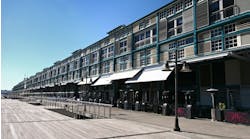Going green is a lot easier if you keep track of all the numbers, which means paying attention to more than just direct construction costs. Indirect costs can easily be 30 to 40 percent of total project cost. Construction loan interest and opportunity costs for a developer’s equity are a significant component. Let’s examine how using systems and products that shorten the construction period and pushing spending into later stages of construction can impact total project cost.
Let’s assume a project has an estimated total cost of $39.1 million, and 32.6 percent – $12.7 million – is indirect cost. The developer has an equity investment of $8.1 million. By investing in this project, the developer will forego the opportunity of earning 11.38 percent on the money during construction. A construction loan of $31 million was arranged at 13-percent annual interest rate. The monthly construction loan draw is $1.325 million. A total of more than $3.315 million of interest expense will incur on $27.825 million of loan draws over the 21-month construction period.
Construction loans are structured so principal and interest are due at the end of the project. As the project moves forward each month, the loan balance grows and so does the interest expense. By month 21, the monthly interest expense is $301,437 or 9 percent of the total interest expense for the project. Condensing the construction period by three months to an 18-month
schedule will cut the total interest expense to approximately $2.864 million, saving $452,156 or 13.6 percent. Additionally, it will reduce the opportunity cost on the developer’s equity from $1.774 million to $1.499 million, saving $275,575.
An advantage of ”greening” the design and engineering process is the savings typically identified in the mechanical and electrical systems that can be used later in the project on items like movable walls; access floors; carpet tile; or higher-grade, longer-life carpet. These items pencil out on a life-cycle cost basis and create more flexibility, but are often cut from the original budget by “first-cost” conscious developers. Delaying a $1 million expenditure from month seven to month 16 of the truncated project reduces interest expense to $2.766 million, saving $97,500.
In this example, interest expense was cut by 16.6 percent, and the opportunity cost on the equity investment was cut 15.5 percent. Total savings: $825,231.
Remember: Green is also the color of money.

